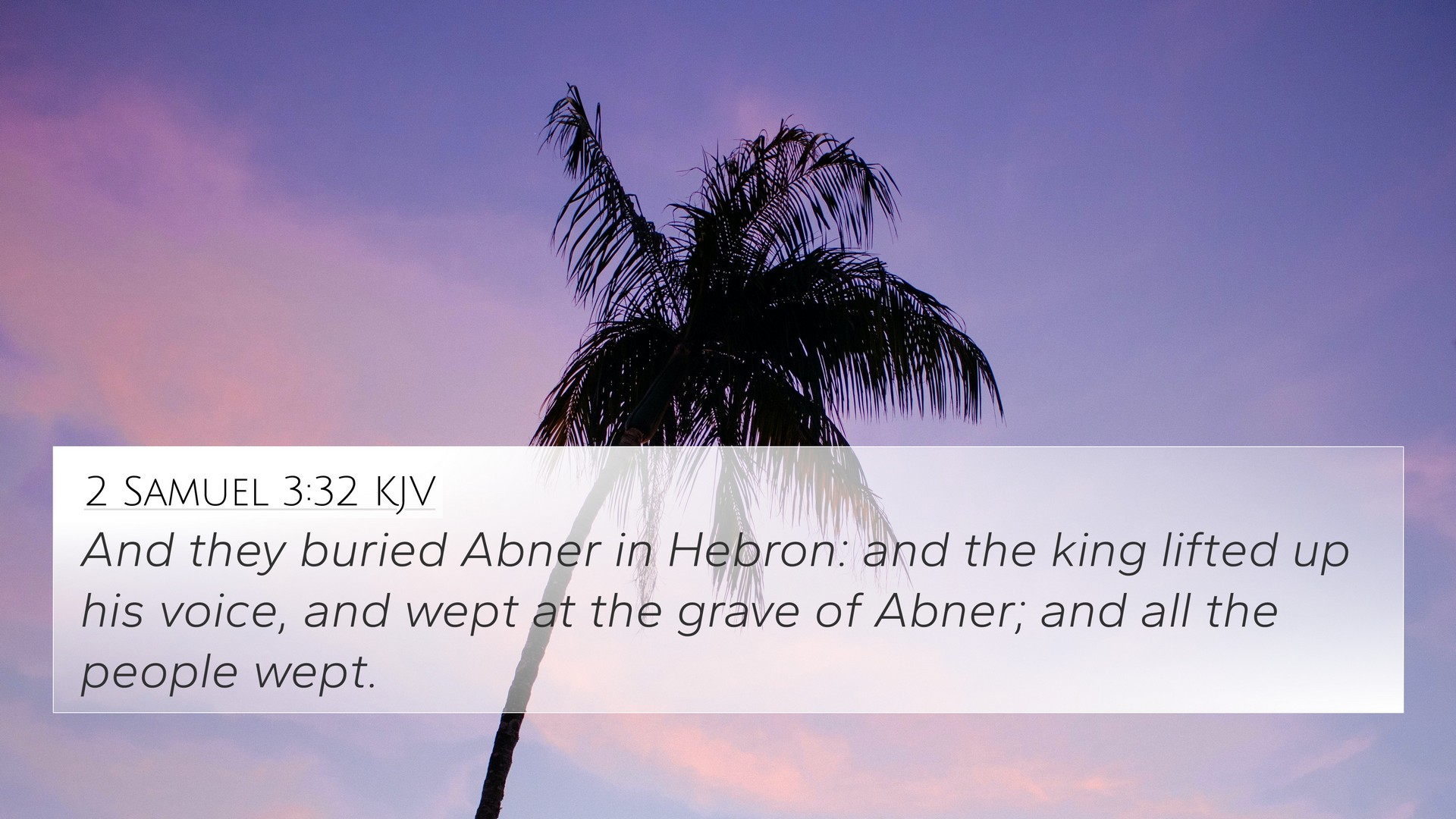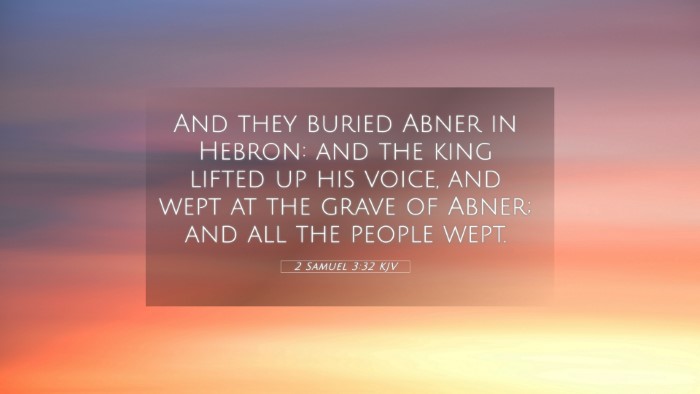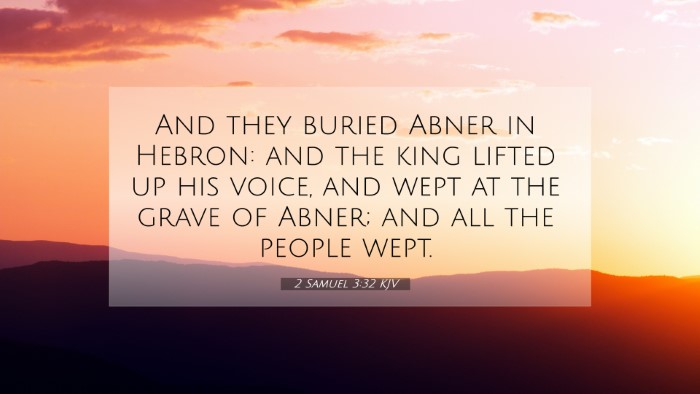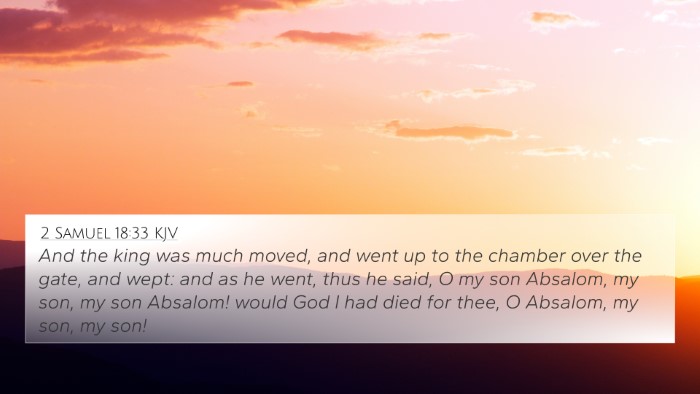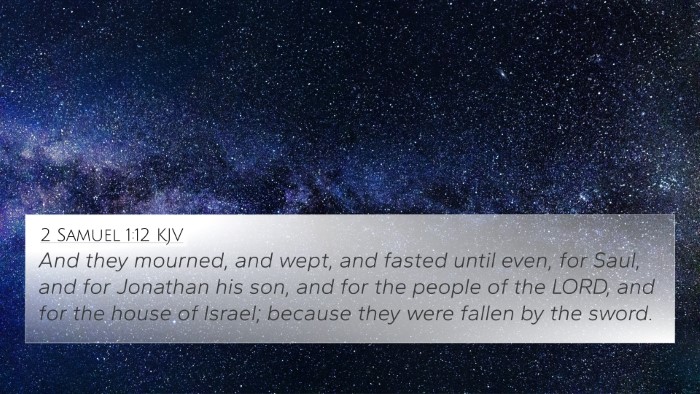Meaning and Interpretation of 2 Samuel 3:32
Verse Text: "And they buried Abner in Hebron: and the king lifted up his voice and wept at the grave of Abner; and all the people wept." (2 Samuel 3:32)
Overview of the Context
This verse takes place during a tumultuous period in the history of Israel, shortly after the death of Abner, the commander of Saul's army. David, the future king, mourns the loss of Abner publicly. This moment signifies the complexities of leadership, loyalty, and the impact of personal loss on national dynamics.
Summary of Commentary Insights
- Matthew Henry: Notes that David's mourning for Abner illustrates the principle of honoring one's enemies. Henry highlights that David not only acknowledges Abner's strength and role in the kingdom but extends grace through his grief.
- Albert Barnes: Emphasizes the significance of Abner's death in the broader political landscape. Barnes points out that David's tears symbolize a lament for lost potential in uniting a divided Israel. The public mourning serves to solidify David’s position as a leader sensitive to the sentiments of his people.
- Adam Clarke: Reflects on the cultural practices surrounding funerals in ancient Israel. Clarke suggests that David’s actions were part of a larger response to maintain peace and demonstrate his integrity as a leader. He notes the genuine nature of David's weeping, further establishing David's character.
Thematic Connections
This verse not only encapsulates personal loss but also has broader implications for leadership, reconciliation, and national stability. Some thematic connections here can be drawn to other scripts in the Bible:
- 1 Samuel 24:17-19: David shows mercy to Saul, reflecting compassion.
- 2 Samuel 1:17-27: David mourns the death of Saul and Jonathan, indicating his honor for those he has lost.
- 1 Kings 2:5-6: The legacy of leadership and justice carries forward, showing David's lessons in conflict resolution.
- Proverbs 11:14: The wisdom in seeking counsel and peace among factions emphasizes the need for unity in leadership.
- Ephesians 4:30-32: Calls for compassion and forgiveness, mirrored in David’s mourning for Abner.
- Romans 12:15: References rejoicing with those who rejoice and mourning with those who mourn, relating to communal grief.
- Matthew 5:4: "Blessed are those who mourn, for they will be comforted" resonates with David's public display of sorrow.
Cross-Referencing Biblical Texts
Understanding 2 Samuel 3:32 can be enhanced through cross-references:
- 2 Samuel 1:11-12: David’s grief serves a similar role as his lamentation for Jonathan and Saul.
- Jeremiah 22:10: A similar theme of mourning is expressed in the context of national calamity.
- Luke 19:41: Jesus weeping over Jerusalem represents a parallel of grieving for lost potential.
- Psalm 34:18: "The Lord is near to the brokenhearted," further emphasizes the themes of compassion during mourning.
- 1 Peter 5:7: Encourages believers to cast their anxieties, linking back to themes of sorrow and leadership.
- Acts 8:2: The devotion to mourning mirrors the early church's lamentation for Stephen.
- Romans 15:1: The responsibility to bear one another's burdens relates directly to David's public mourning.
Practical Applications
The implications of 2 Samuel 3:32 extend into modern-day concepts of leadership, grief, and reconciliation. Here are some practical applications:
- The importance of recognizing grief in leadership is critical in any organizational structure.
- Public expressions of sorrow can unite a people in times of crisis, showing empathy and solidarity.
- Forgiveness and memorialization of rivals can pave the way for healing and unity.
- Identifying connections between one's own experiences of loss and communal practices can facilitate deeper understanding and support.
Conclusion
In conclusion, 2 Samuel 3:32 is rich with layers of meaning that reflect the complexity of human emotion, leadership, and the ties that bind communities. Meditating on this passage can encourage believers to reflect on their own practices of mourning, reconciliation, and the importance of recognizing the value of every individual’s contributions, regardless of their past allegiances.
Tools for Further Study
If you wish to dive deeper into biblical cross-referencing and understanding themes, here are some tools:
- Bible concordance - Tool for locating specific verses and their contexts.
- Bible cross-reference guide - Helps to find related scriptures quickly.
- Cross-reference Bible study methods - Systems for connecting different Biblical texts.
- Comprehensive Bible cross-reference materials - Resources for exploring thematic connections.
- How to use Bible cross-references - Practical guidelines for effective study.
- Identifying connections between Old and New Testament - A focused approach for deep study.
